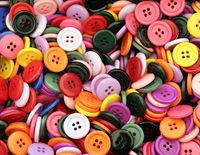Button
In modern clothing and fashion design, a button is a small fastener, now most commonly made of plastic, but also frequently of metal, wood or seashell, which secures two pieces of fabric together. In archaeology, a button can be a significant artifact. In the applied arts and in craft, a button can be an example of folk art, studio craft, or even a miniature work of art.
Buttons are most often attached to articles of clothing but can also be used on containers such as wallets and bags. However, buttons may be sewn onto garments and similar items exclusively for purposes of ornamentation. Buttons serving as fasteners work by slipping through a fabric or thread loop, or by sliding through a buttonhole. Other types of fastenings include zippers, Velcro and magnets.
Styles of attachment
- Shank buttons have a hollow protrusion on the back through which thread is sewn to attach the button. Button shanks may be made from a separate piece of the same or a different substance as the button itself, and added to the back of the button, or be carved or molded directly onto the back of the button, in which latter case the button is referred to by collectors as having a 'self-shank'.
- Flat or sew-through buttons have holes through which thread is sewn to attach the button. Flat buttons may be attached by sewing machine rather than by hand, and may be used with heavy fabrics by working a thread shank to extend the height of the button above the fabric.
- Stud buttons (also push-through buttons or just studs) are composed from an actual button, connected to a second, button-like element by a narrow metal or plastic bar - pushed through two opposing holes within what is meant to be kept together, the actual button and its counterpart press it together, keeping it joined. Popular examples of such buttons are shirt studs and cufflinks.
- Snap fasteners (also pressure buttons or press studs) are metal (usually brass) round discs pinched through the fabric. They are often found on clothing, in particular on denim pieces such as pants and jackets. They are more securely fastened to the material. As they rely on a metal rivet attached securely to the fabric, pressure buttons are difficult to remove without compromising the fabric's integrity. They are made of two couples: the male stud couple and the female stud couple. Each couple has one front (or top) and rear (or bottom) side (the fabric goes in the middle).
Fabric buttons
- Covered buttons are fabric-covered forms with a separate back piece that secures the fabric over the knob.
- Mandarin buttons or frogs are knobs made of intricately knotted strings. Mandarin buttons are a key element in Mandarin dress (Qi Pao and cheongsam in Chinese), where they are closed with loops. Pairs of mandarin buttons worn as cuff links are called silk knots.
- Worked or cloth buttons are created by embroidering or crocheting tight stitches (usually with linen thread) over a knob or ring called a form. Dorset buttons, handmade from the 17th century to 1750, are of this type.
Button sizes
The size of the button depends on its use. Shirt buttons are generally small, and spaced close together, whereas coat buttons are larger and spaced further apart. Buttons are commonly measured in lignes (also called lines and abbreviated L), with 40 lignes equal to 1 inch. For example, some standard sizes of buttons are 16 lignes (10.16 mm, standard button of men's shirts) and 32 lignes (20.32 mm, typical button on suit jackets).
Chat rooms • What links here • Copyright info • Contact information • Category:Root
